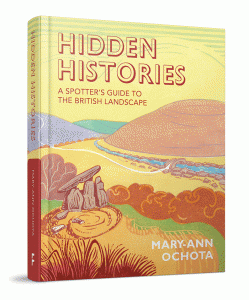Overview
Hidden Histories: A Spotter’s Guide to the British Landscape is a really interesting and fascinating book that helps to interpret what we see whilst out and about in the countryside.
is a really interesting and fascinating book that helps to interpret what we see whilst out and about in the countryside.
The book sets out to be a guide in answering questions we’ve all had whilst travelling through the countryside – from the more subtle areas such as very strangely shaped hills or mounds that might be man made, geological or glacial through to the more obviously man made artifacts such as stone circles, stone crosses and roman roads.
Each area is well covered with detailed descriptions, photographs, things to look out for and also things to be wary of – many natural features can closely resemble man made ones. There really is a wealth of information presented and some truly fascinating facts. I particularly liked the Top 5 lists such as Top 5 Stone Circles and also the sketches showing how some of these amazing structures may have been built without any machinery – Stone Henge is perhaps the most famous of these and certainly one of the most striking but there were plenty of others that were equally fascinating such as the huge and almost 6,000 year old West Kennet Long Barrow chambered tomb, Silbury Hill which is the largest man made mound in Europe (and part of the Avebury site including the huge stone circle surrounding the village) and Grimes Graves neolithic flint mine (Norfolk), again over 5,000 years old!
Whilst reading the book the common and mind-blowing theme is the sheer size of many of these undertakings, whilst Grimes Graves looks like a strangely pock marked field now, 5,000 years ago it was a flint mine with around 400 shafts which went upto 40 foot (12m) deep – pretty impressive when digging with deer antler picks! From around the same era there is also Pike o’Stickle Neolithic Axe Factory in Cumbria with the vast vertical scree suggesting that over 100,000 axes were prepared in this area! Slightly more recently there’s also some impressive architecture in the Orkney Isles such as the Knap of Howar or the perhaps more famous Skara Brae along with numerous other wide ranging examples such as Roman Roads, Hedges, Hill Forts, Commons and Plague Villages all covered in the book under chapters of Lumps and Bumps, Stones, Lines and In the Village.
Verdict
Anyone who has event he slightest interest in archaeology and / or anthropology will find this book a really useful guide in helping to interpret possible former uses for the land. More than that though it was a truly fascinating read and a great insight into our early civilisations and a lovely overview to the long, rich and varied history of the British Isles. Reading the book certainly rekindles the enthusiasm to get out into the countryside and look again with a little bit more knowledge and a keener sense of curiosity for finding things both on the doorstep through to visiting some of the stunning sites showcased and discussed in the book. Highly recommended and available on Amazon.





